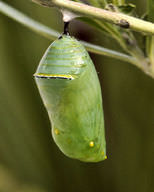9.17 Insect Reproduction
9.17 Insect Reproduction
What is this?
These butterfly eggs look like tiny pearls on a leaf. The adult butterfly often lays her eggs on a specific type of plant. This ensures that the future caterpillars will have plenty of food to eat.
Insect Reproduction and Life Cycle
Most insects can reproduce very quickly within a short period of time. With a short generation time, they evolve faster and can quickly adjust to environmental changes. Most insects reproduce by sexual reproduction. The female produces eggs, which are fertilized by the male, and then the eggs are usually placed near the required food. In some insects, there is asexual reproduction during which the offspring come from a single parent. In this type of reproduction, the offspring are almost identical to the mother. This is most often seen in aphids and scale insects.
With a few exceptions, all insect life begins as an egg. After leaving the egg, insects must grow and transform until reaching adulthood. Only the adult insect can mate and reproduce. The physical transformation of an insect from one stage of its life cycle to another is known as metamorphosis.
Three Types of Metamorphosis
An insect can have one of three types of metamorphosis and life cycles (Table below). Metamorphosis describes how insects transform from an immature or young insect into an adult insect in at least two stages. Insects may undergo gradual metamorphosis (incomplete), where transformation is subtle, or complete metamorphosis, where each stage of the life cycle appears quite different from the others. In some insects, there may be no true metamorphosis at all.
| Type of Metamorphosis | Characteristics | Examples |
|---|---|---|
| None |
|
Silverfish, firebrats, springtails |
| Incomplete |
|
Dragonflies, grasshoppers, mantids, cockroaches, termites |
| Complete |
|
Butterflies, moths, flies, ants, bees, beetles |
The chrysalis (pupal stage) of a monarch butterfly.
Summary
- Insects reproduce rapidly, usually by sexual reproduction.
- Metamorphosis, or how insects transform from an immature form into an adult, can be part of the insect life cycle.
Explore More
Use the resources below to answer the questions that follow.
Explore More I
- Growing Up Butterfly
- How many eggs will a female monarch butterfly lay?
- How much heavier is the caterpillar two weeks after birth?
- Describe the changes that turn the caterpillar into a butterfly.
Explore More II
- Insect Reproductive Systems
- How do male insects try to keep other males from impregnating a female with which they have mated?
- Do most insects use internal or external fertilization?
- What do male insects make with the accessory glands of their reproductive system?
Review
- Describe how most insects reproduce.
- Define metamorphosis.
- What is the difference between complete and incomplete metamorphosis.
- What are the four stages of complete metamorphosis?
- Describe the differences between the immature and adult forms of most insects.
- Give three examples of insects that go through complete metamorphosis.
- Log in or register to post comments
- Email this page


